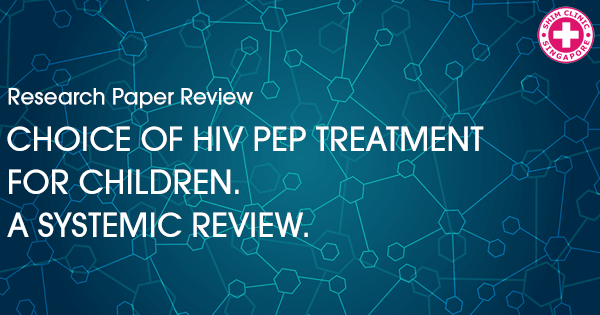The Human Immunodeficiency Virus (HIV) is not an adult-only disease but is also known to infect infants and children. The common causes of HIV infections in children are usually accidental needle stick injuries, premastication and sexual assault. Guidelines for adults recommend a base of tenofovir with lamivudine (3TC)/emtricitabine (FTC) and a third drug which is either a protease inhibitor or an integrase inhibitor. However, there is currently a lack of data to help form recommendations for age-appropriate HIV PEP formulations for children of different ages.
A recently published systemic review gathered the published data on the drugs and therapies used for HIV post-exposure prophylaxis (PEP) as well as ART for children living with HIV to make recommendations for the safe use of antiretroviral post-exposure prophylaxis in children. This study was conducted to help establish WHO guidelines on the choice of drugs to be used in PEP for children.
Method
To prepare this report two different systemic reviews were conducted. In one of the works, published data was searched for studies which reported safety and completion rates of PEP in children. In the second review work, published data was searched for to find available evidence on the safety and efficacy of drugs used for antiretroviral medication therapy. The age group selected for the study were children at age 10 or younger – this age range was selected because children above 10 years old are usually given the same treatment as adults.
Results
Completion Rates
For the first part of the study, out of total 97 studies screened initially, 3 prospective cohort studies were selected as per the selection criteria of the study. According to the reports, children in these studies (following injuries from needles in Canada and South Africa as well as sexual assault in Malawi) were given zidovudine and lamuvidine as part of a two-drug PEP therapy. This regimen had a completion rate of 64% in children receiving the medication for 28 days. The percentage of children who discontinued PEP due to adverse effects was 4.5%.
Efficacy and Risks
The second part of the study to evaluate the efficacy of drugs used as NRTI backbones, one randomized trial was identified to be included in the study. This paper compared abacavir with lamuvidine (3TC) and zidovidine with lamuvidine (3TC) and found that the regimen containing abacavir had better efficacy but the study reported one death and 1 treatment discontinuation due to hypersensitivity reaction.
3 studies were included to assess the choice of the third drug for children less than 3-year old. These studies compared lopinavir to nevirapine and found that there was a lesser risk of treatment discontinuation due to reactions when lopinavir was used. It was found that here was no difference in the efficacy of these drugs in children of age more than 3.
Conclusion
This paper concluded that a regimen of limuvidine, ziduvidine and lopinavir is recommended for a three-drug HIV PEP medication to be used on children. The medication should, however, be administered according to the weight of the children.
The alarming thing pointed out in the report is that there is very little published research related to drug efficacy, toxicity and usage in children affected or exposed to HIV. More studies are urgently required in this field so that better recommendations for the PEP of HIV in children can be formulated and tested.
Source:


Pingback: HIV Morning-After Pill: How it Works and When to Take it